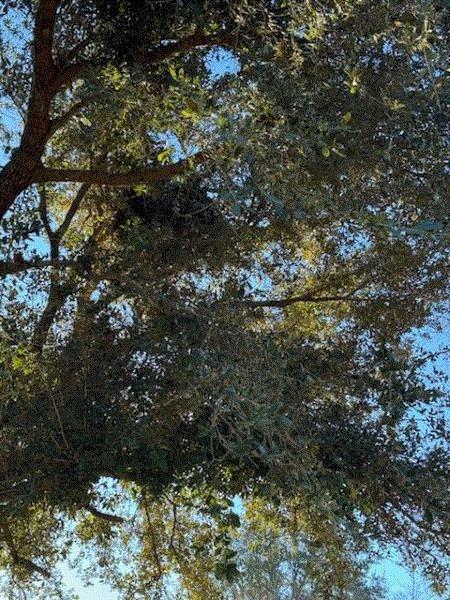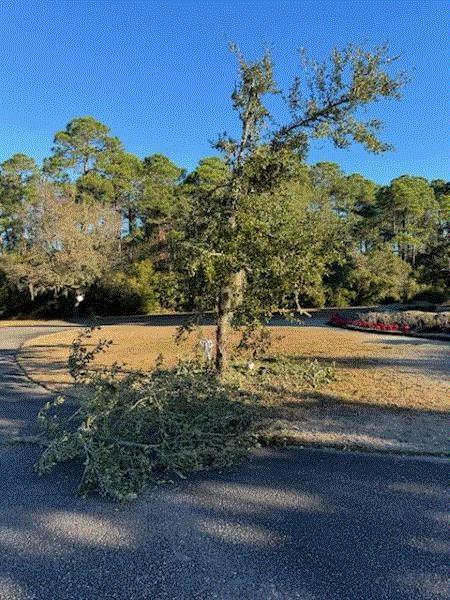What the ... ?
Todd Stephenson, an arborist serving the Grand Strand area of South Carolina, and I had been chatting about crape myrtle bark scale in the past few months. You don’t know where Grand Strand is? Grand Strand is the 60-mile stretch of beachfront land from Little River on the North Carolina-South Carolina border to Georgetown, South Carolina. If you are a golfer, you’ll be able to find a favorite among the 80 (some say 90) golf courses along this stretch. But we ain’t here to talk about golf today.
Todd shared with me a few pictures of live oak trees planted in a community near Myrtle Beach. The top branches were broken and piled on the trees. The same damage is observed in many trees throughout the area.

Branches are broken and piled on this live oak tree in Myrtle Beach, South Carolina. (Photo credit: Todd Stephenson, Total Tree Care, Inc.)
What’s going on here? I can tell you what didn’t cause the damage. It’s not a monkey or ape that has escaped from one of several wildlife attractions in Myrtle Beach. I’m watching you, Kingussie Kong. (I like this nickname so much better than Honshu.)

Gowan Acquires Ag Use of Cyromazine
Y’all might have heard in January that Gowan had acquired the global rights to the insecticide cyromazine from Syngenta. Now, here is a little detail that some folks may have missed: The acquisition only concerns agricultural uses of cyromazine. Trade names for agricultural uses include Trigard in the United States. The deal doesn’t cover Citation, which is for ornamental uses. Syngenta retains the right to Citation.
Cyromazine is an insect growth regulator that specifically targets flies. In ornamental production, Citation is one of the most effective products against leafmining flies (leafminers), fungus gnats and shore flies. Since Citation is an insect growth regulator that’s effective only against larvae, you want to start treatment as soon as the pest population (such as fungus gnats caught on sticky cards or dancing on the rim of pots) or damage (such as stippling or small mines by the leafminers) is detected.
Wet spray of Citation is used against leafminers and, in my experience, the addition of a sticker-type surfactant to the spray solution increases its efficacy. For fungus gnats and shore flies, Citation should be applied as sprench or drench at sufficient volume to wet at least the top couple of inches of media. Also, you want to make sure the solution is applied to the media evenly to achieve the best efficacy.

What’s for Aphids on Spring Crops?
I’ve gotten a few calls and emails about aphids in the past few weeks. Not surprising, really, since aphids are more problematic for me in the spring and fall. They aren’t too active in the summer. You may have a different experience about their timing outside of the South. Let me know.
To me, aphids are one of those pests that could be managed successfully and easily with biological control. There are quite a few biological control agents for aphids, from lacewings to tiny parasitic wasps of many species. Banker plants are adopted by quite a few growers. A grower I worked with reduced his insecticide spray from more than 10 down to four on his spring crop a couple of years ago. His major complaints about the banker plants are the need to dedicate space and labor to grow and maintain the banker plants and to prepare and deploy the banker plants ahead of an aphid outbreak. The last time I checked in, he was considering if he wants to use banker plants again. I hope he does. Email me or go HERE if you want additional information on how to set up a banker plant system.

A banker plant system for aphids. (Photo credit: OMAFRA)
Aphids aren’t difficult to control with insecticides, well, at least in my experience. The difficulties, particularly in the South, come from the constant invasion of winged aphids into the greenhouses via opened vents and sides. A population can quickly blow up in your greenhouse because of how rapidly the aphids grow (become reproductive in a little more than a week) and how many babies they pump out (one hundred in a couple of weeks). So, catching the invasion of aphids with sticky cards and regular inspection is the key in preventing an outbreak.
Which of the insecticides are effective? Can I say all of them? Seriously, I haven’t really tested an insecticide that doesn’t knockback aphid population. I can spray a solution of diluted dish soap and kill the aphids, even though I won’t get any residual control from the spray. Again, the key is to catch the infestation early and treat them before an outbreak occurs.
One of the major pains of aphid management is residual control of aphids in hanging baskets. Neonicotinoids are the standards for aphid management in hanging baskets, where just one drench can produce a relatively clean crop. They still are if you can and want to use neonicotinoids in your operations. When neonicotinoids were under scrutiny, folks tried and reported good results with other systemic insecticides, such as flupyradifurone (Altus) and spirotetramat (Kontos).
Lots of insecticides are available for foliar application. My go-to are the chordotonal organ modulators in two IRAC groups—afidopyropen (Ventigra; 9D), flonicamid (Aria; 29), pymetrozine (Endeavor; 9B), and pyrifluquinazon (Rycar; 9B). Obviously, two IRAC groups aren’t enough to build a rotation program, which is essential for aphids. There are other effective options, such as azadirachtin (many trade names; UC), several insect growth regulators, diamides, neonicotinoids, flupyradifurone, spirotetramat, sulfoxaflor, entomopathogenic fungi, horticultural oil and insecticidal soap.
Here is a self-promotion: Go HERE for a poster from SePRO (prepared by me) on insecticides available for the management of aphids and other pests.

Answer to “What the … ?”
When Todd told me that the branches were “nests” made by black bears, I went, “WHAT??!!” I always assume that bears are rare or non-existent in the coastal plains of South Carolina. Sure, there are plenty of them in the mountains, but along the coast? I always thought a few might wonder accidentally to the lower elevation, but I didn’t know they are more than transient.
There are two major populations of black bears in South Carolina—one in the mountains and a smaller one in the upper coastal pine lands—according to the South Carolina Department of Natural Resources. The numbers of reported human-bear contacts had stayed relatively steady in the past few years, at 49 along the coastal counties in 2019 (the most recently available data). Many of the sightings of bears were associated with bears venturing into residential neighborhoods to rummage through trash. The influx of retirees and new residents into the Grand Strand also squeezed the habitats of black bears, pushing them out to forage in human territory.

I guess this young tree couldn't take the weight of a bear fattened on human trash. (Photo credit: Todd Stephenson, Total Tree Care, Inc.)
I guess some of these bears, after they’d been satiated on trash and didn’t feel like going back to the woods, decided to make overnight dens using the branches of young live oak trees. The napping spots are off the ground at least. Human amazement didn’t faze the napping bears apparently.
My thanks to Todd for sharing the pictures. I love to learn about something new! Keep your sightings of “What the … ?” coming.

GrowerTalks Webinar on Water Issues
Water is perhaps one of the most important but overlooked inputs in our industry. One important lesson I’ve learned from my career is how easily we can circulate some pathogens though reused water. Years ago, Ed (an orchid grower in South Carolina) asked me what he could do about the Erwinia rots that’s ravaging his super-high value crop. A younger me could only stammer at that time. Now that I have an opportunity to visit many growers, I realize the same challenge is faced by growers throughout the country, especially when they rely on water drawn from retention ponds for irrigation. The only difference is that now I work for a company that has many aquatic solutions that could be considered.
I’ll also learn from Kurt Becker of Dramm. Kurt and I communicated previously on low-volume application, on which Dramm is a leader. But this time, Kurt will be giving a webinar on common water issues and their solutions on March 17 at 1:00 p.m. Eastern. Kurt has 30 years of experience in helping growers with their water and pest management.
Register for the webinar by going HERE. I look forward to seeing y’all at the webinar.




See y'all next time!

JC Chong
Technical Development Manager at SePRO
Adjunct Professor at Clemson University
This e-mail received by 27,847 subscribers like you!
If you're interested in advertising on PestTalks contact Kim Brown ASAP!